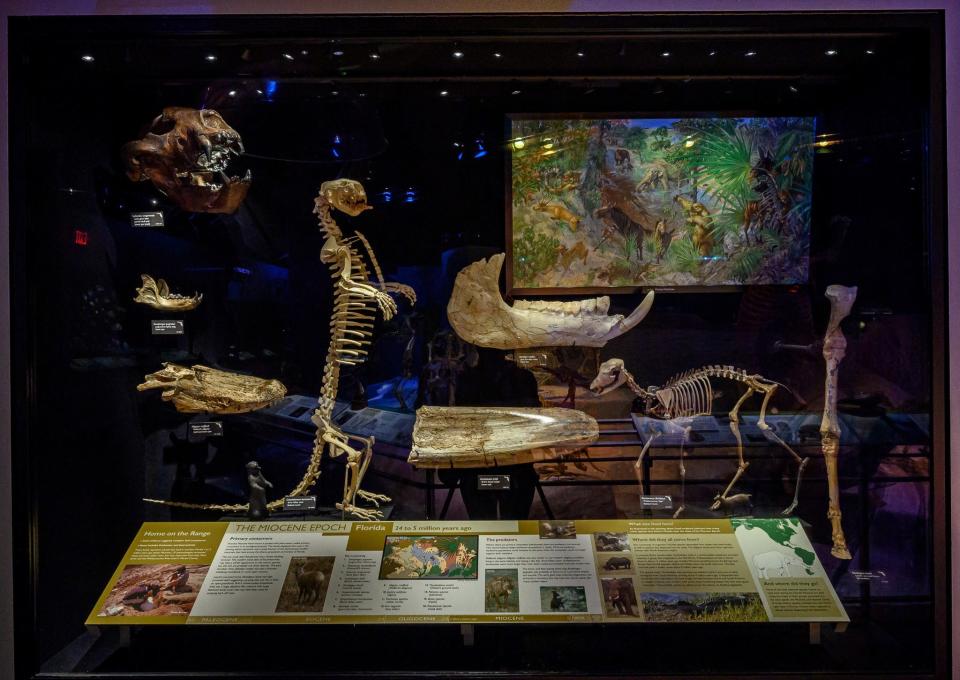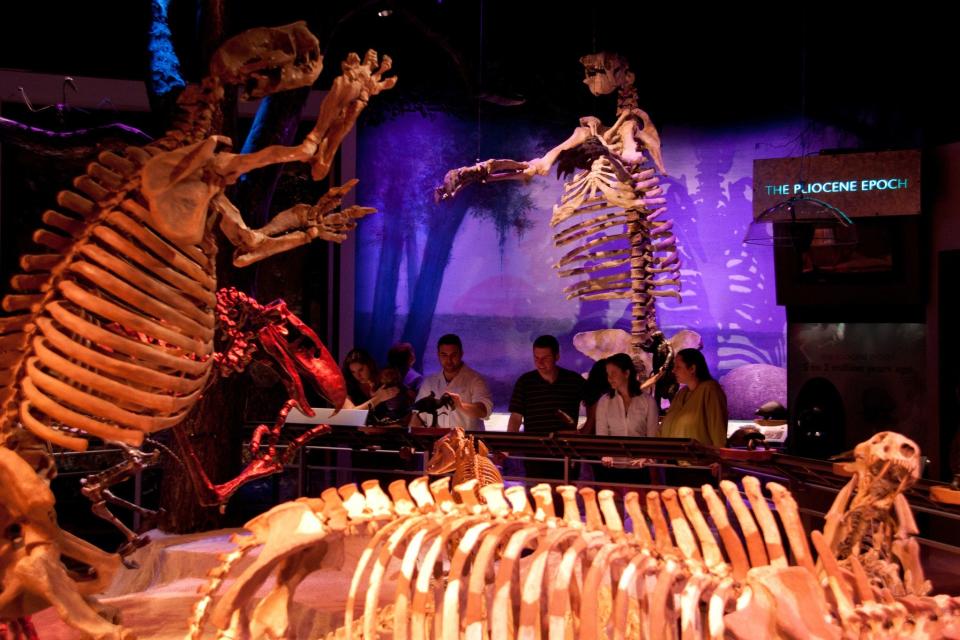Bone-crushing dogs and 3-ton sloths among prehistoric animals that roamed Florida
Florida archaeologists recently discovered several complete skeletons of an extinct species of elephants called gomphothere, marking a historic find at the Florida Museum of Natural History’s Montbrook Fossil Dig site.
Portions of a gomphothere were first discovered in the “elephant graveyard” in early spring last year, but researchers didn’t think much of it until a volunteer found the articulated foot of something bigger.
Within a few days, it became clear there was not just one but several complete skeletons, including one adult and at least seven juveniles.
Gomphothere graveyard in Florida: 'Once-in-a-lifetime': 5 million-year-old 'elephant graveyard' found in Florida
Great white pinged off Florida coast: 1,400-pound great white shark Breton pings off the coast of Florida
Jonathan Bloch, curator of vertebrate paleontology at the Florida Museum of Natural History, said the discovery was a “once-in-a-lifetime” find, adding that it was the most complete skeleton from its time period in Florida and among the best in the U.S.
Over the past 35 million years, researchers say that over 1,000 different species of vertebrate animals are known to have lived in Florida. The state has the richest fossil record of vertebrate animals of the eastern U.S., underlining the excitement of the new discovery, and prompting many others to wonder what other animals roamed Florida.
Aepycamelus major (Leidy’s giraffe camel)
Aepycamelus major, also known as Leidy’s giraffe camel, lived between 9.5 and 6 million years ago. They are likely Florida’s tallest land mammal, according to the Florida Museum, standing about 13-feet-tall at the shoulder and an additional 5 or 6 feet for the neck.
Where fossils were found:
Alachua County—Haile 16C; Love Site; Tyner Farm
Levy County—Mixson’s Bone Bed
Marion County—Crystal Springs Mobil Home Park; Emathla; Withlacoochee River 5E
Canis dirus (dire wolf)
The Canis dirus, commonly called the dire wolf, lived between 500,000 and 11,000 years ago. The Florida Museum says they weighed an estimated 130 to 150 pounds, which is about 25% heavier than the gray wolves we know today.
Where fossils were found:
Canis dirus fossils have been dug up in dozens of sites around Florida, including Brevard, Duval, Sarasota and more.
Enhydritherium terraenovae (giant otter)

Enhydritherium terraenovae were large otters capable of living in both freshwater and coastal habitats. The idea of giant otters might sound foreign, but modern species, like the giant river otter, can stretch to nearly 6 feet tall and weigh up to about 70 pounds. Enhydritherium terraenovae were even larger, clocking in at up to 100 pounds.
Where fossils were found:
Marion County-Moss Acres Racetrack Site; Withlacoochee River 4A
Polk County-Brewster Mine; District Grade Mine; Fort Green Mine; Fort Meade Mine (Gardinier); Whidden Creek Site in Fort Meade Mine (Gardinier); Palmetto Mine; Phosphoria Mine; Rockland Mine
Eremotherium eomigrans (wandering giant ground sloth)

Eremotherium eomigrans, more commonly known as the wandering giant ground sloth, were true to name — weighing in at an estimated 3 tons, according to the Florida Museum. This species of giant ground sloth is one of the largest known from North America. A composite skeleton can be found on display at the Florida Museum, consisting of bones from two similar-sized animals.
Where fossils were found:
Eremotherium eomigrans fossils have been found in dig sites spanning 11 counties including Alachua, De Soto and Hillsborough counties.
Giant Florida sloth fossil found: Time to celebrate 45 years of sloth | MARK LANE
Arctodus pristinus (lesser short-faced bear)
Arctodus pristinus, also known as the lesser short-faced bear, was the largest land carnivore in Florida during the early Pleistocene era (2.5 million to 500,000 years ago) and are closely related to the spectacled bear of South America. Arctodus pristinus fossils are abundant in Florida, with more found here than anywhere else.
These bears, whose face may have resembled that of a bulldog, were large and powerful. It is estimated that arctodus pristinus could stand between 8 and 10 feet tall and weighed about 2,000 pounds.
Where fossils were found:
Arctodus pristinus fossils have been found in sites spanning 10 counties including Alachua, Brevard, Citrus, Hillsborough and Sarasota counties.
Smilodon fatalis (sabertooth cat)
Smilodon fatalis is more famously known as the sabertooth cat — yep, the one you see plastered beside a wooly mammoth in nearly every pop-culture reference to prehistoric times. Smilodon fatalis isn’t the only saber-toothed cat, but it’s the one most are familiar with. These cats were about the same size as modern Siberian tigers, according to the Florida Museum, weighing between 350 to 600 pounds.
They lived between 700,000 and 11,000 years ago and covered a swathe of land as researchers have discovered fossils as far as Los Angeles. Other species have been found spanning across continents.
Where fossils were found:
Smilodon fatalis fossils have been found in sites spanning 15 counties, but are still considered uncommon as most records are isolated teeth or bones.
Epicyon haydeni (bone-crushing dog)

Epicyon Haydeni are the largest canid ever known. These bone-crushing dogs were the size of grizzly bears and, thankfully, lived between 12 and 6 million years ago. Despite references to bears, these borophagine dogs are often compared to hyaenas because of their food-processing behavior, and notably their dental and cranial similarities.
During their time, borophagine dogs often showcased a high range of diversity. Hypercarnivorous borophagines tended to be quite large while those with more omnivorous diets were smaller. Epicyon Haydeni were the former, and their unique dental specializations allowed them to crush open bones like modern hyenas today.
Where fossils were found:
Alachua County — Haile 19A; Love Bone Bed; McGehee Farm
Hardee County — Fort Green Mine (#8 Dragline)
Levy County — Mixon’s Bone Bed; Waccasassa River 6
Polk County —F our Corners Fauna (Fort Green Mine; Nichols Mine; Nichols Mine Stream Matrix; Payne Creek Mine); Phosphoria Mine; Silver City Mine
Carcharocles megalodon (megalodon)
Carcharocles megalodon, probably the only animal on the list recognizable from the scientific name alone, is known simply as the megalodon. These massive sharks lived between 23 and 3.6 million years ago and were considered one of the most feared predators at the time.
Megalodons were roughly three times the length (up to 60 feet) of modern great white sharks, according to the Smithsonian, and are the largest shark to have ever lived. Its name, which means “big toothed glorious shark,” is apt as each tooth is as large as an adult human’s hand.
Where fossils were found:
Shark skeletons are predominantly cartilage, which makes finding one millions of years old difficult. Teeth and vertebrae of megalodon have been found widespread all around Florida — often times right on the beach.
This article originally appeared on Pensacola News Journal: Gomphotheres aren't Florida's only prehistoric animal. Here's 8 more

 money
money 